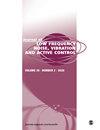Vibration alleviation for wind turbine gearbox with flexible suspensions based on modal interaction
IF 2.4
4区 工程技术
Q1 ACOUSTICS
Journal of Low Frequency Noise Vibration and Active Control
Pub Date : 2023-01-10
DOI:10.1177/14613484221145183
引用次数: 1
Abstract
Wind turbine drivetrains play a fundamental role in converting wind power into electrical energy. The gearbox is one of the most important and expensive components in a wind turbine drivetrain. Since flexible suspensions mounted on the gearbox are mainly designed for isolating vibration transfer to other turbine components, the gearbox itself still suffers from complicated whole-body vibration. In view of this, a vibration absorption method based on modal interaction is put forward to alleviate the whole-body vibration of the wind turbine gearbox with flexible suspensions. A vibration absorber with adjustable control parameters is utilized to establish modal coupling with the wind turbine gearbox. Internal resonance is analyzed and used to construct a modal interaction mechanism between the vibration absorber mode and the controlled gearbox mode. With the help of modal interaction, the vibration energy of the controlled gearbox mode is successfully absorbed by the vibration absorber mode and effectively dissipated by the damping of the vibration absorber mode. Through numerical simulations and virtual prototyping simulations, its vibration alleviation performance is verified. Since the proposed method is designed in terms of the controlled mode of the wind turbine gearbox rather than external excitations, it is suitable for applications in a complicated working environment. Besides, the proposed method aims to transfer and dissipate vibration energy through nonlinear modal interaction rather than suppress vibration via external energy, and thus can effectively deal with strong vibration problems. More importantly, it can easily work together with the existing vibration isolation method and further alleviate the whole-body vibration of the gearbox. This research will contribute to improving the reliability and service life of wind turbine gearboxes.基于模态相互作用的风电齿轮箱柔性悬架减振研究
风力涡轮机传动系统在将风力转化为电能的过程中起着重要作用。齿轮箱是风力涡轮机传动系统中最重要也是最昂贵的部件之一。由于安装在齿轮箱上的柔性悬架主要用于隔离振动传递到其他涡轮部件,因此齿轮箱本身仍然面临复杂的全身振动。鉴于此,提出了一种基于模态相互作用的减振方法来缓解柔性悬架风电齿轮箱的整体振动。利用控制参数可调的吸振器与风力机齿轮箱建立模态耦合。通过内部共振分析,建立了减振器模态与受控齿轮箱模态之间的模态相互作用机制。借助模态相互作用,受控齿轮箱模态的振动能量被吸振模态成功吸收,并被吸振模态的阻尼有效耗散。通过数值仿真和虚拟样机仿真,验证了其减振性能。由于该方法是根据风力发电机齿轮箱的受控方式而不是外部激励进行设计的,因此适合于复杂工作环境下的应用。此外,该方法的目的是通过非线性模态相互作用传递和耗散振动能量,而不是通过外部能量抑制振动,因此可以有效地处理强振动问题。更重要的是,它可以很容易地与现有的隔振方法协同工作,进一步减轻齿轮箱的整体振动。该研究将有助于提高风力发电机齿轮箱的可靠性和使用寿命。
本文章由计算机程序翻译,如有差异,请以英文原文为准。
求助全文
约1分钟内获得全文
求助全文
来源期刊

Journal of Low Frequency Noise Vibration and Active Control
Engineering-Mechanical Engineering
CiteScore
4.90
自引率
4.30%
发文量
98
审稿时长
15 weeks
期刊介绍:
Journal of Low Frequency Noise, Vibration & Active Control is a peer-reviewed, open access journal, bringing together material which otherwise would be scattered. The journal is the cornerstone of the creation of a unified corpus of knowledge on the subject.
 求助内容:
求助内容: 应助结果提醒方式:
应助结果提醒方式:


